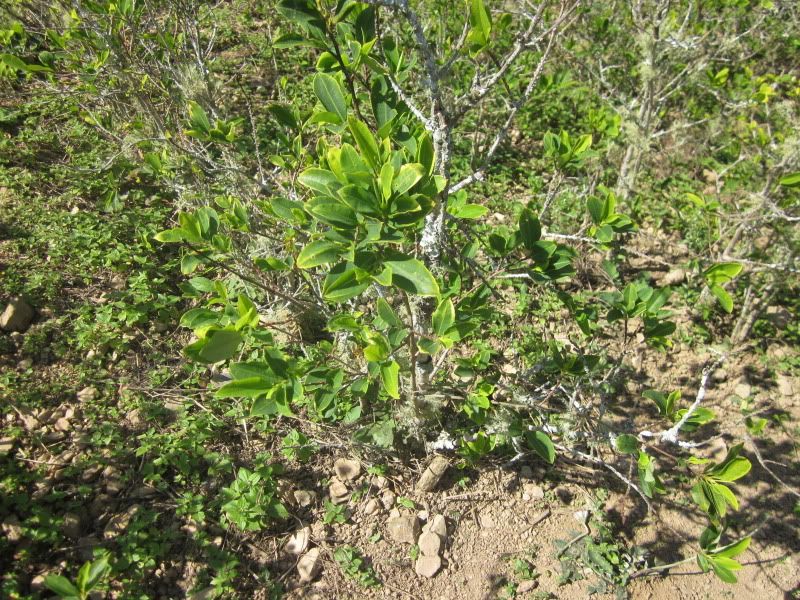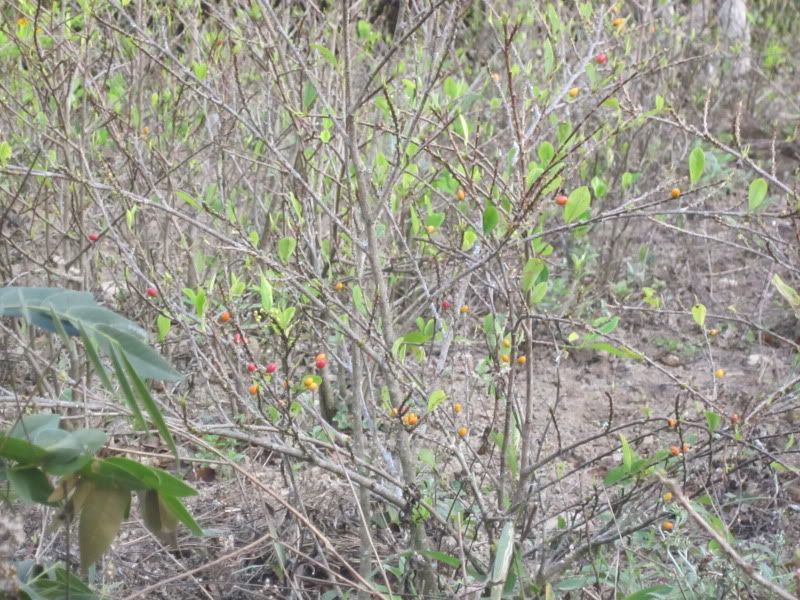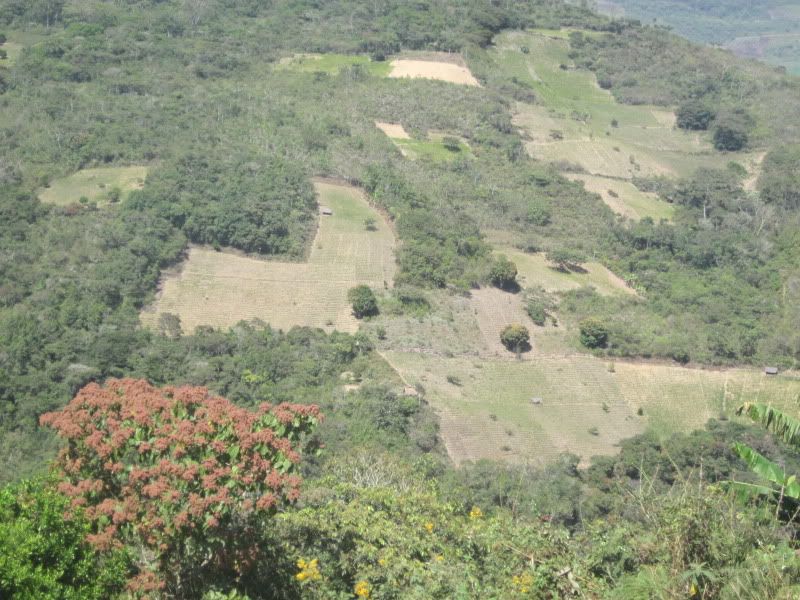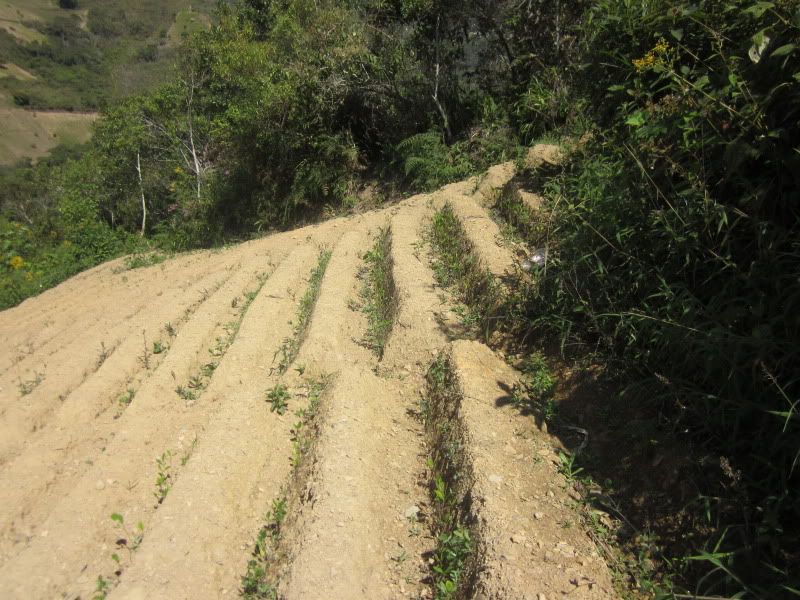We began our morning in Yungas (near Coroico) with a nice walk over to meet Don Gregorio, a local community leader who was kind enough to show us how he grows coca. In Yungas, there's a dusty dirt road that goes along through the mountains, and below it are towns, homes, and farms. Above it is forest that is used as communal hunting and gathering space. Often, wild plants are used as medicines as well as foods. Communally managed forests can also provide firewood, which is needed especially for people who lack cooking gas. As we waited for Don Gregorio, we saw a gorgeous bird, a male swallow tanager:

This is Wikipedia's picture... mine wasn't nearly as good.
Once Don Gregorio arrived, he introduced himself. To describe his role in the community, I must explain the syndicate structure. Each indigenous peasant community in Bolivia forms a "syndicate" that uses a very participatory form of democracy. All of the community will come together for the syndicate meetings. Meetings are conducted in the indigenous languages. The people are called to the meetings by the sound of the pututu, made from a cow's horn (there's a picture in the El Alto Market diary). People who were not born in the area, even if they have moved there and lived there for years, are not included in the syndicate.
In Yungas, the syndicate leaders are elected. Elsewhere, the community rotates the leadership position among each man in the community. A group of syndicates will come together to form a "sub-central," and several "sub-centrales" come together to form a "central." If a person goes against the community or breaks the local rules, the syndicates will administer punishments. (In some areas in the Altiplano, the syndicates will even lynch criminals.) This is how local democracy is administered. And, from what I gathered, these syndicates, sub-centrales, and centrales exist outside of the official Bolivian government.
Back to Don Gregorio, he is the leader of his Sub-Central. Therefore, he's an important guy in local politics. With our introductions out of the way, we began walking down the mountain to Don Gregorio's cocal (coca field).
As we walked, Don Gregorio ran us through the normal day of a coca-growing family. The woman wakes up first, before 5am, and she prepares the food for the day. For breakfast, she makes soup and herbal tea (like the sultanas leftover from coffee production). Then she makes rice or noodles, boiled plantain, egg or charque (jerkey) or dried salted fish from the Amazon or other smaller fish from Lake Titicaca (isp'i) for lunch. The man will eat first and go to the field. The fields are far from their homes so it is a long walk. The woman will then eat, clean up, and leave for the field, bringing food for lunch with her.
Coca is a traditional crop in Bolivia, as it has been chewed or drank as tea and used in religious ceremonies for centuries. The two most important coca growing areas are Yungas (where we were) and the Chapare. Yungas is considered the traditional coca-growing zone. Although yields are lower there than in the Chapare, the leaves are considered smaller, sweeter, and more desirable for coca chewing and rituals.
At last we arrived at Don Gregorio's coca, where we saw coca plants for the first time.

A coca plant

Very green coca leaves. These must be a darker green before they are ready to be harvested.

A plant with light and dark green leaves.

Another coca plant.

A coca plant with fruit

Don Gregorio's cocal
Don Gregorio's cocal is just under one cato, a quarter hectare. Evo Morales passed a law that every farm family can grow one cato of coca. Don Gregorio's cocal is seven years old. Typically, a family will clear land via slash and burn and then, for one year, grow crops like maize, cassava, or Andean crops to help prepare the soil. Then the farmer will prepare the soil for coca by building stepped terraces called wachus (details and photos below).
Coca is germinated and grown in seedbeds that are protected from the sun. After the seedlings grow for about a year to a height of about 15 centimeters, they are transplanted into the soil.

Don Gregorio's area for germinating coca seeds (under the wooden poles).
Coca growing is incredibly labor intensive and the soil is very poor. Yungas is known as the "traditional zone" for growing coca, but because this region has grown coca for so long, the soil is often worn out. (That said, coca annually uses far fewer nutrients than corn.) Most people do not use soil amendments here, but some people will use composted chicken litter or even some urea fertilizer. Below are photos showing how much of the land is devoted to coca, how steep the slopes are, and how the terraces are constructed.

A view across the valley at coca fields.

A really steep slope
Wachus:
The construction of wachus or terraced steps is the technique most frequently utilized. The soil is prepared to a depth of some sixty centimeters, work which is done manually because of the steepness of the slopes. Then terraces are built following contour lines, beginning at the low end of the field and proceeding to the upper end of the slope. The wachus can vary between thirty to fifty centimeters in altitude, depending on the slope of the field. Between each [wachu] a ditch or canal of about ten centimeters deep and twenty centimeters wide is then prepared where shade is maximized and humidity is retained. The coca plants will later be transplanted within the outer edge of the canal, where conditions favorable to the rapid growth of roots are optimum.
The actual building of the wachus is done with a tool called a paleta, a flat wooden board with a handle which workers pound and compact the soil to stabilize the recently formed terrace steps. They later cover these with a thin layer of soil to smooth their surfaces. In this way the completed wachus look like little mud walls. Rainwater collects and is absorbed inside the canals, preventing all runoff. In addition, the working of the soil in the process of constructing wachus has the added advantage of minimizing weed growth. - Coca, Cocaine, and the Bolivian Reality by Madeline Barbara Leons and Harry Sanabria, p. 214-215.
This was described to us by Don Gregorio, who said they wait til the rainy season so the soil is soft. Then they hold a board up to the soil and beat it to form the steps. The baby coca must be planted in the rainy season or else it would need to be irrigated (if it were planted in the dry season). Coca can be harvested one year after it is first planted.
The wachus are very effective at preventing erosion:
This is because the coca shrub, without being cut back, as it is every few years or so, would turn itself into a small tree several meters high. An extensive root system develops over time and holds the soil in place. - Coca, Cocaine, and the Bolivian Reality by Madeline Barbara Leons and Harry Sanabria, p. 218-219.
The mention of cutting back the plant refers to the practice of pruning the tree after productivity begins to decline (after about five years) to 10-15 cm above the soil. This is called pillu. In fields more than 20 years old, this is done every 3 years. In this way, a coca field can stay productive for several decades.

Wachus (terrace steps)

Newly built terraces.

View from below.

If you can see, baby coca plants (wawa coca) are planted right at the base of each step.

There's a small depression at the base of each step.

Wawa coca growing (and some weeds too)
Harvest takes place about every three months, depending on rain. When the leaves are harvested, they are placed in a bag the called a mitiña. Then they are dried before they are stored and sold. The entire family will help with the coca harvest. Don Gregorio told us that when there is good weather, he can get 70 lbs of coca from his field. According to the same book I quoted above, productivity is about 900kg per hectare. Currently, coca is going for 28-30 Bolivianos (US$4-$4.25) per pound.
Because harvest is labor intensive, often families will hire workers to help with the harvest. They are paid about 3 Bolivianos per pound or perhaps 75 Bolivianos for a very productive day of work. Often college students in this area work to pay for their education by harvesting coca.
In the past, there was an equal, reciprocal relationship in which people would share labor. This is called ayni. Ayni represents two people who are equals, so they can each help one another harvest coca and the amount of help they give is roughly equal to the amount they receive.
A second form of traditional labor sharing is called minca (or minka). If one person has more land than the other, then there will be a payment made to the person who owns less land for harvesting the wealthier person's land. This is still more traditional and personal than day labor, in which you work for someone you have no relationship with and you are paid for your work.
These forms of traditional labor sharing are somewhat dying out in favor of day labor.
Don Gregorio told us that he does not use any chemicals on his land. He also showed us his license, emphasizing that his coca is grown and sold legally.
In addition to coca, this area grows oranges, tangerines, coffee, limes, peanuts, corn, walusa, taro, plantains, rice, cassava, squash, and hot peppers. I even saw a little bit of sugarcane growing. There is some cash cropping done with squash and hot peppers that use quite a bit of agrochemicals in this area. Don Gregorio told us that sometimes the people here will bring oranges and plantains to the Altiplano to exchange them at the markets for chuño.
One thing that's notable about some of the other crops grown in this area for sale compared to coca is that coca can be harvested and sold one year after sowing, whereas other crops (coffee, citrus) would require more time before they provide a crop after planting.
No comments:
Post a Comment